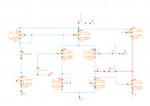ed_gops
Newbie level 3
- Joined
- Dec 8, 2013
- Messages
- 4
- Helped
- 0
- Reputation
- 0
- Reaction score
- 0
- Trophy points
- 1
- Location
- Visakhapatnam
- Activity points
- 34
Hello everyone!!! I want a circuit which should produce a constant output voltage using MOS in cadence. I have done a design too, and its working fine. But I don't know whether it is acceptable for practical purpose or not. The design is done in 90nM CMOS Technology. The logic for the second stage for the image below is not clear. A NMOS is placed between the PMOS and NMOS of the inverter where the drain of two NMOS are connected together, so that there will be no effect of NMOS drain voltage change and a constant output (logic 1) is achieved upon any change in the input (for logic 1). Now the constant output 1.999V can be used to get any desired value at the output of the NMOS with diode connected PMOS load. Please, clarify me if this circuit is logically correct. If not send a design for the same requirement. Thanks in advance.


